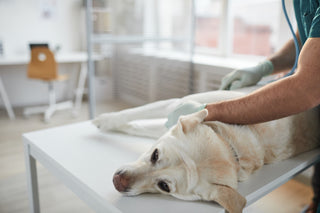Aircan® is a novel oropharyngeal cannula designed for dogs, particularly brachycephalic breeds. Inspired by traditional human oropharyngeal airways, Aircan® facilitates a
clear airway by allowing free airflow from the mouth to the larynx.
Intended Use -
• Aircan® is intended to maintain a patent airway in anesthetized or unconscious animals without swallowing reflexes.
• It is indicated for use before and after general anesthesia or in emergency situations.
• It is especially useful in brachycephalic breeds.
• Aircan® is not a replacement for laryngeal masks or endotracheal tubes.
Design & Function -
• The unique design displaces the soft palate dorsally while depressing the tongue, increasing airway permeability.
• Its 22 mm connector allows attachment to standard patient connectors and circuits, facilitating oxygenation through FiO, enrichment.
• Lateral wings, a square neck, and three external rings keep the device in place, preventing rotation and displacement.
Material & Reusability -
• The cannula is made from carefully selected materials, making it durable and
reusable after proper cleaning.
• Aircan® is not sterile and can be reused after proper washing.
• It is recommended to clean the Aircan® with water and an enzymatic, non-ionic detergent, followed
by disinfection using chlorhexidine, quaternary ammonium compounds, or 700/o alcohol.
• Keep it dry, in a moisture-free place.
• Aircan® cannot be autoclaved.
Sizes -
Aircan® is designed for different sizes of dogs:
• Small breeds: Pekingese, Pug, and Shih Tzu.
• Medium breeds: French Bulldog and Boston Terrier.
• Large breeds: English Bulldog and Boxer.
Placement & Monitoring -
• The length of the Aircan® is selected by measuring externally from the incisors to the occipital protuberance along the head.
• The cannula should be inserted through the oral cavity of the sedated animal.The longer, free end must be oriented toward the palate; ensure that the Aircan logo is facing the nose to confirm correct orientation.
• The insertion depth may vary depending on the animal's anatomy and the cause of the obstruction; the degree of insertion must be assessed.
• Airway patency should be evaluated after placement, and adjustment of the device may be necessary.
• If the obstruction worsens, the device must be removed and the situation reassessed.
• The patient usually expels the device once it can no longer tolerate it, but this process must be supervised. If necessary, it may be gently removed from the mouth.
Contraindictions -
• Aircan® should not be used in conscious patients.
• It is contraindicated in patients with vomiting or airway obstructions that do not involve the soft palate or tongue.
Benifits -
• Aircan® quickly and safely opens the airway.
• It is well-tolerated by patients and useful during anesthetic recovery.
• It is easy to place and effective.
• It is helpful for managing the airway in brachycephalic breeds.
• It can be used both before and after general anesthesia, as well as in sedated patients.
https://www.youtube.com/watch?v=6bthIRMUT4E













